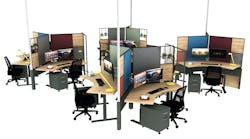Long-Term Design Solutions to Create Meaningful, Lasting Workplaces Post-Pandemic
In our previous installment of this two-part series, we discussed concerns about returning to the office and workspace solutions to curtail the spread of the virus. This segment analyzes long-term solutions and the implications for the future of workspace design.
All the proposals to combat COVID-19 (and any future viruses) are based on increasing separation and reducing contact between people. This is a controversial point, both generally, as we are social beings who have an inherent need to be with others, and specifically for the modern workplace that, during the past few decades, has favored maximizing human interaction.
Another major, yet overlooked, part of the workday involves the journey between home and office. We can employ many solutions for lowering the risk of viral transmission in the workplace, but how can we mitigate contamination for the millions of people who commute each day by public transportation?
[Related: Short- and Mid-Term Solutions for Reopening Offices - Part 1]
The packed train, bus or ferry is the antithesis of a safe environment in a COVID-19 world, and while public transportation agencies have implemented measures to ensure distancing and improve cleanliness, most people are likely to avoid mass transit in favor of the safety of their car. Additionally, taxis, Uber and Lyft, and shared bikes and scooters are likely to see extremely limited use as the notion of touching surfaces previously exposed to past riders will scare most away.
The next round of workplace design and construction will see the refinement of the short-term to mid-term solutions mentioned earlier and the incorporation of new measures, such as:
- Specially designed, isolated entry vestibules with mandatory temperature and/or viral testing, and application of protective gear at employee entry
- On-site clinics for identifying, isolating and preliminarily treating before leaving the premises for home quarantine or hospitalization
- Outdoor meeting spaces specially designed to allow groups to gather with appropriate separation and access to fresh air and sunlight Routine monitoring of staff health, which will require HR and legal solutions to address personal privacy concerns
- New building codes focused on bacterial control and reduced occupancy
- New health and safety design consultants, specializing in developing measures that satisfy new health codes and combat the spread of infections
- Updates to the WELL Building Standard or development of new LEED-like programs to assure employees and visitors of compliance with safety measures
Silicon Valley companies and the design community have long agreed that innovation constantly requires new ideas, which frequently come from workplace interactions among colleagues. Tech companies discovered the benefits of workplace proximity, regular interaction and the resulting staff collaborations. Private offices, high cubes and spatial features that siloed individuals were gradually discarded to maximize connectivity, spontaneous encounters, collaboration, personal bonds and common values. The workplace has evolved into a preponderance of shared “we” spaces.
Several companies also believe that spontaneous encounters between employees who normally do not work together—in the spaces away from workstations and scheduled meetings—generate new ideas and innovative breakthroughs. Thus, denser open office plans and the proliferation of various spaces for meeting, socializing, presenting and training have become the design requisites—all intended to maximize interaction and collaboration with the added benefit of refining and fostering company culture.
[Related: Design for Wellness Beyond Today]
The initial COVID-19 solution possibilities and the personal apprehensions they introduce are at odds with the environmental and cultural characteristics we associate with modern workplaces. Early in this pandemic, we were left with more questions than answers. Asking the questions—identifying the issues and problems—is the first step toward meaningful solutions. We are programming for the next phase of the workplace with a new layer of health and safety analysis.
Even after a potential vaccine, we will still be responsible to do all we can to combat new infections so that illness is minimized and the economy can safely continue more effectively. New workplace questions revolve around finding the right balance between interaction, separation, safety, and privacy.
For each industry, shared goals and coordinated efforts are the essences of a successful organization. Traditionally, we relied on direct personal communication and face-to-face exchanges, believing this would always be preferable for meaningful and productive discussions, negotiations, resolutions, agreements and progress.
As companies have been forced to adapt during the shelter-in-place period, additional fundamental, philosophical questions arise about the future of work: If we have the tools to work from home, why do we need an office? What is “the office” when no one is there? What is a company when its people do not come together?
The answers to such questions will be revealed in the coming months and years as we transition back to the office and deal with the economic and emotional impacts of COVID-19. The answers will vary depending on the necessities of each industry and the tools available.
About the Author:
Paul Ferro is the CEO and co-founder at Form4 Architecture. With his fellow principals at San Francisco-based Form4, he is a laureate of the 2017 American Prize for Architecture.
Read Next: Redefining Healthcare Interior Design and Materials in a Post-Pandemic World

